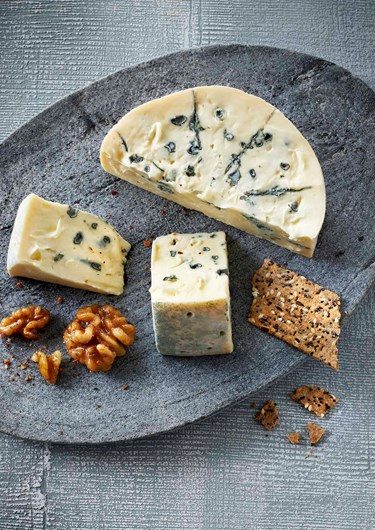
Double Crème Blue
What is Castello Double Crème Blue?
Inspired by the mild and delicate nature of white mold cheeses and the intense profile of a traditional blue cheese, the Double Crème Blue has become a classic of its own. Kickstarting your palate, it opens gently, slowly intensifying as it sits on your tongue. Braced with tones of toasted hops, the flavors are mild, bordering on tangy, with a creamy consistency to garnish and complete the profile. Its ivory-colored body, imbued with blue veins that stretch like gushing rivers, is certain to sit perfectly at any table and beside any dish.
First introduced in 1969, the traditional ways of making the Double Crème Blue are still maintained today, ensuring the same level of quality. A harmonic blend of light aromas and mild flavors make this cheese a nuanced and intricate experience worthy of sharing or enjoying on your own. Having a milder profile than a Danish Blue, it is the perfect choice for audiences that are unversed in blue mold cheeses.
Pair your Double Crème Blue with toasted rye bread, fresh pears and roasted nuts, or let it accompany seared game or sit atop baked potatoes. Serve at room temperature by removing the cheese from the refrigerator at least half an hour before serving.
How Double Crème Blue is made
From a nation of agriculture, Danish dairy farmers hold a strong catalogue of knowledge and experience that strongly echo in their cheese.
In mid-Jutland, Danish Jersey and red-pied cows provide fresh milk to the Gjesing dairy. The pasteurized milk is poured into traditional open vats, with added enzymes and a special blend of cultures encouraging the development of blue mold. Once the milk has curdled with the help of rennet, it is cut and milled to release excess whey, allowing for a smoother consistency. Placed in molds, the curd is drained once more, before finally receiving a coating of salt to shield it from unwanted mold. Workers then pierce the rind with steel needles, allowing the mold to develop and breathe from the center of the cheese. After the aging process, the cheese has fostered its marbling and achieved its soft and pliable texture.
Substitutes for Double Crème Blue
Holding its own among the long lineage of blue mold cheeses, being able to discern between the seemingly subtle differences is crucial when looking to replace your Double Crème Blue.
Another Danish favorite, the Danish Blue (often referred to as Danablu) is full-flavored, salty and sharp in taste. Extravagant in its nuances, it presents an intense piquancy with a firm and crumbly consistency. A great pairing for roast veal, fresh berries and honey.
Looking further south, the Italian Gorgonzola presents itself as a charismatic take on a blue mold cheese. Slight salty, it can range anywhere from mild to brash in flavor, offering vivid contrasts when paired with pasta dishes and zesty marmalade. Beautifully formed, Gorgonzola is in many ways similar to Danish Blue. Its soft and crumbly texture stands in stark contrast to its brash and bold taste. Also made from cow’s milk, it spans a wide range of roles. With a slightly salty taste, it is sure to be a capable substitute for Double Crème Blue.
Roquefort is made from sheep’s milk and is closely related to Danish Blue. Similar in appearance, the taste is sharper and the texture crumblier.
Curious about the world of cheese? Here's everything you need to know about how to store, serve and cut cheese!







